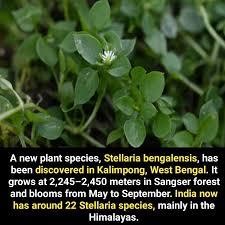Researchers Discover New Plant Species Stellaria Bengalensis
Why in the news?
Scientists from North-Eastern Hill University have discovered Stellaria bengalensis, a new plant species in Kalimpong, India. This finding adds to the country’s biodiversity and highlights the ecological richness of the Himalayan region.
Identification of a New Species:
- Researchers from the Centre for Advanced Studies in Botany, North-Eastern Hill University, Shillong, have discovered a new plant species, Stellaria bengalensis.
- This species belongs to the genus Stellaria (family Caryophyllaceae) and was found in the Sangser forest, Kalimpong, at altitudes between 2,245-2,450 meters.
- It adds to India’s diverse flora, specifically in the Himalayan region, which is known for its high-altitude ecosystems.
Distribution and Conservation Status:
- India is home to around 22 species of Stellaria, mostly found in the Himalayan region.
- Stellaria bengalensis is currently classified as “Data Deficient” by the International Union for Conservation of Nature (IUCN) due to limited data on its population and distribution.
- Another species from the genus, Stellaria mcclintockiae, was previously discovered in Kerala, further underlining the country’s rich plant biodiversity.
About Stellaria Bengalensis:
- Annual herb of the genus Stellaria (family Caryophyllaceae).
- Found in muddy soil slopes at altitudes of 2,245-2,450 meters in Sangser forest, Kalimpong.
Characteristics:
- Height: 8-10.5 cm.
- White flowers, no bracts, shorter petals, sharp pointed seeds.
- Flowers and fruits between May to September.
Distribution and Status:
- India has 22 Stellaria species, mostly in the Himalayan region.
- Classified as ‘Data Deficient’ by IUCN.
- Related species: Stellaria mcclintockiae discovered in Kerala.
Key Characteristics of Stellaria bengalensis:
- The plant is an annual herb that grows to a height of 8-10.5 cm.
- It has white flowers and lacks bracts, with petals shorter than the sepals.
- The plant features sharp, pointed seeds and blooms from May to September.
- It thrives in muddy soil slopes, showcasing its adaptation to the high-altitude environment.
Sources Referred:
PIB, The Hindu, Indian Express, Hindustan Times




